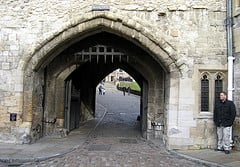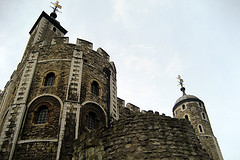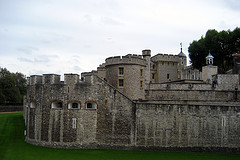The Pretenders
The Pretenders
There were two pretenders to the throne of England in Henry 7th's reign. The first was a boy called Lambert Simnel and the second was Perkin Warbeck. The history of the pretenders begins with one of the great mysteries of British history – the disappearance of two young boys, Princes of the Realm, from the Tower of London. The 12-year-old prince of Wales was staying at Ludlow Castle in Shropshire when, on 9 April 1483, news came of his father's death and the boy became King Edward V. Edward 4th's sudden death brought his brother, Richard, Duke of Gloucester into the regency as ‘protector of the realm’ until Edward came of age, and he also took on the care of the Prince's younger brother, 10-year-old Richard, Duke of York. The pretenders, downright imposters were put forward as the missing princes in the hope of duping the authorities.
Gate at Bloody Tower

The Princes in the Tower
The Duke of Gloucester and his men intercepted Edward’s entourage as it travelled to London and escorted him to London, and then to the Tower. There, on 16 June, he was joined by his brother Prince Richard.
Robert Stillington, a priest presented evidence that King Edward IV contracted to marry Lady Eleanor Talbot before marrying Elizabeth Woodville, the princes' mother. This made his marriage to Elizabeth invalid and the princes illegitimate. The Duke of Gloucester was invited by Parliament to take the crown as Richard III, as his other brothers, Edmund and George, had both died before Edward IV, leaving Gloucester next in line for the throne.
The two boys were last seen playing in the grounds of the Tower at around the time their uncle had them declared illegitimate. It has been presumed that they were murdered on his orders, but to this day, five centuries later, nobody knows for sure.
More on the Princes
- The Princes in the Tower - Richard Duke of York and Edward Vth
The heritage of britain- history and accommodation guide, including castles, hotels, inns, manor houses, bed and breakfast and cottages as well as a history magazine
The White Tower

Lambert Simnel
Richard the third's reign was short. Henry Tudor claimed that the throne should be his and he would do his best to take it from Richard. Their armies met at Bosworth field in Leicestershire in 1485 where Richard was killed and his army defeated. Henry was crowned King Henry 7th.
Richard Symonds, a priest from Oxford noticed that one of his pupils, Lambert Simnel had a striking similarity to the sons of Edward IV – the Princes in the Tower. Symonds, first decided to pass off Simnel as the younger of the two princes, Richard of York, but then decided to pass him off as George, Duke of Clarence's son, the Earl of Warwick, Symonds took Lambert Simnel to Ireland as it had been a centre of support to the Yorkists, and the Lord Lieutenant there, the Earl of Kildare, proclaimed Simnel as King Edward V. The pretender to the throne was supported by the Duchess of Burgundy – King Edward IV's daughter. She sent a force of 2000 German mercenaries to Ireland commanded by Martin Schwarz – a talented military leader. Backed by this force, the Irish became more confident and actually crowned Lambert Simnel King Edward 5th in Dublin in May 1487.
The challenge to Henry 7th's throne seemed absurd, but it had to be dealt with. Henry VII had to squash the uprising quickly, especially when the Earl of Lincoln, one of Henry's allies, changed sides and fled to Ireland, also in May 1487. If Henry lost control of his senior nobility, his chance of remaining king was limited and at the very least the War of the Roses would restart. Lincoln was a senior nobleman and he had to be dealt with.
On June 4th, 1487, Lincoln and his army landed at Furness in Lancashire. After crossing the Pennines, he turned South. But the support that Lincoln wanted was not forthcoming. The people were suspicious of the Irish soldiers who accompanied Lincoln and did not rally to his cause. They were concerned that another civil war was starting with all the upheaval and hardships that went with it. Henry was prepared for Lincoln and the two armies met just outside of Newark on June 16th 1487. Lincoln’s army was 8,000 strong while Henry's was around 12,000 men. At the start, Lincoln’s force had the upper hand as the German soldiers who were with Schwarz proved effective. However, Henry's army held firm and at the end Lincoln, Schwarz, and the leader of the Irishmen, Thomas Geraldine, were killed. Over half of Lincoln’s force was wiped out.
As the Earl of Warwick was actually alive and living in the Tower, Henry VII ordered that he be paraded through London, thus showing Simnel to be the impostor he was.
Despite the fact that there had been an uprising against the king on Lambert Simnel’s behalf and the boy had actually been crowned in Ireland as ‘Edward V’, Henry pardoned him. He recognised that the boy had been simply a puppet. The king took him into his employment, firstly as a servant in the royal kitchen, then as a royal falconer, which post he kept for the rest of his life.
Tower of London

Perkin Warbeck
Again, in 1491, a young man appeared, claiming to be Richard Duke of York, the younger of the two ‘princes in the Tower’. His story was that he had survived, escaped to Europe and gone into hiding. Now he emerged to claim his rightful place on the English throne. His name was Perkin Warbeck.
Warbeck first claimed the English throne at the court of Burgundy in 1490. In 1491, he landed in Ireland in the hope of rallying support, but he was out of luck and he was forced to return to the European mainland. He was received by King Charles 8th who later signed a treaty with England, agreeing not to shelter rebels. He therefore had to expel Warbeck. Then he was recognised as Richard by Edward 4th's sister, Margaret of Burgundy, the widow of Charles 1st, Duke of Burgundy. She tutored him in the ways of the Yorkist court,even though she may have known he was an imposter. Henry 7th complained about the harbouring of Warbeck, but the Archduke, who had assumed control of Burgundy in 1493, ignored him. So Henry imposed a trade embargo on Burgundy, cutting off their important trade links with England. Warbeck was also welcomed by various other monarchs, attending the funeral of Frederick 3rd, Holy Roman Emperor in Vienna, where he was recognised as King Richard IV of England.
On 3 July 1495, funded by Margaret of Burgundy, Warbeck landed in Kent, hoping for a show of support, but his small army was routed and 150 of the pretender’s troops were killed. Warbeck was forced to retreat almost immediately and he headed for Ireland. He found support there from the Earl of Desmond and laid siege to Waterford, but as the resistance was too strong for his men, he fled to Scotland. He was received with open arms by James 4th of Scotland, who jumped at the chance to annoy England, and he was invited to marry James's cousin, Lady Catherine Gordon.
In September 1496, Scotland launched an attack on England, but quickly retreated when support failed to materialise from Nothumberland. James was now fed up with Warbeck and wanted to be rid of him, so James IV signed the treaty not to shelter rebels and had Warbeck expelled. The pretender returned to Waterford in shame. Once there, he again attempted to lay siege to the city, but the opposition was still too strong for him and he was forced to flee, being chased out to sea by four English ships. According to some sources, by this time he was left with only 120 men on two ships.
On 7 September 1497, Warbeck landed in a bay near Land's End in Cornwall, hoping to capitalise on an uprising that had occurred a few months earlier. Warbeck promised the Cornish men that he would put a stop to the extortionate taxes that henry had levied on them to help fight a war against Scotland. He was welcomed enthusiastically and declared "Richard IV" on Bodmin Moor. His new, Cornish army were 6000 strong and they entered Exeter and advanced on Taunton. King Henry sent Lord Daubeney to attack the Cornish and when Warbeck heard that the King's men were at Glastonbury, he panicked and fled, deserting his army. He was captured in Hampshire at Beaulieu Abbey, where he surrendered. Henry VII's men overran the rebels on 4 October 1497 and the Cornish army surrendered. The ringleaders were executed and others fined. Warbeck was hauled to London and imprisoned in the Tower of London, after being “paraded through the streets on horseback amid much hooting and derision of the citizens.”
Perkin Warbeck was imprisoned in the Tower alongside a genuine claimant to the throne, Edward Earl of Warwick and the two of them tried to escape in 1499. They were captured, and this time there was only one outcome. On 23 November 1499, Perkin Warbeck was drawn on a cart from the Tower to Tyburn, where he read out a confession and was hanged.








